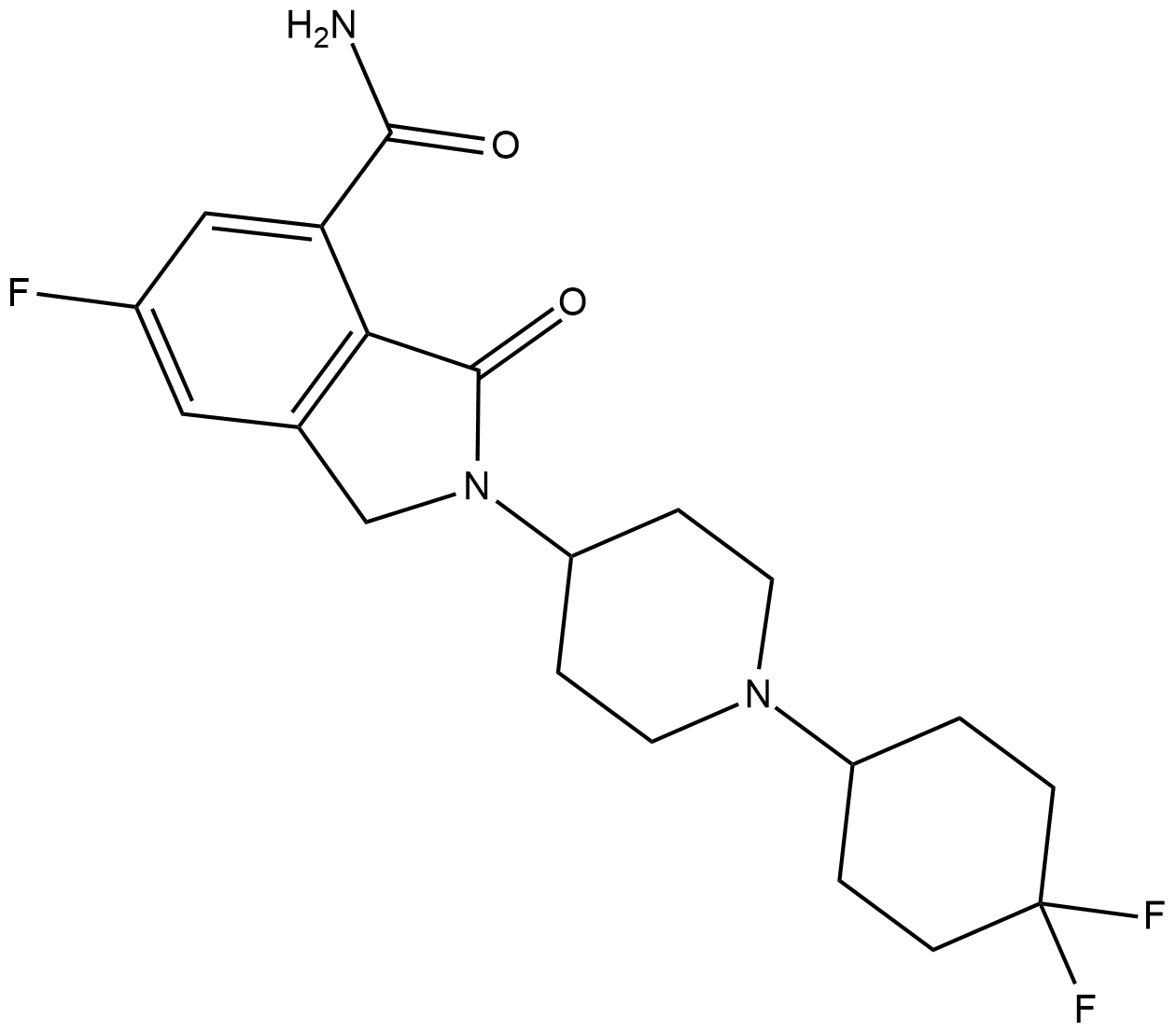NMS-P118 |
| カタログ番号GC19264 |
NMS-P118 は、癌治療のための強力で経口投与可能な選択性の高い PARP-1 阻害剤です。
Products are for research use only. Not for human use. We do not sell to patients.

Cas No.: 1262417-51-5
Sample solution is provided at 25 µL, 10mM.
NMS-P118 is a potent, orally available, and highly selective PARP-1 Inhibitor for cancer therapy.
NMS-P118 is found to be less myelotoxic in vitro than olaparib (now marketed as Lynparza), a dual PARP-1/-2 inhibitor. NMS-P118 proves to be metabolically stable, it modestly inhibites two cytochrome P450 family members (CYP-2B6 IC50: 8.15 uM; CYP-2D6 IC50: 9.51 uM) out of eight isoforms tested. Its ability in hampering the proliferation of bone marrow cells is from 5 to > 60 times lower then olaparib according to the species[1].
NMS-P118 is a potent (KD=0.009 uM) PARP-1 inhibitor, showing 150-fold selectivity over PARP-2 (KD=1.39 uM). NMS-P118 possesses excellent pharmacokinetic profile and nearly complete oral bioavailability both in mice and rats. It proved to be highly efficacious in vivo both as single agent in MDA-MB-436 human breast cancer tumors and in combination with temozolomide in CAPAN-1 human pancreatic tumors growing as xenografts in the mouse. The compound is well tolerated at highly efficacious doses and is endowed with an excellent ADME profile[1].
References:
[1]. Papeo G, et al. Discovery of 2-[1-(4,4-Difluorocyclohexyl)piperidin-4-yl]-6-fluoro-3-oxo-2,3-dihydro-1H-isoindole-4-carboxamide (NMS-P118): A Potent, Orally Available, and Highly Selective PARP-1 Inhibitor for Cancer Therapy. J Med Chem. 2015 Sep 10;58(17):6875-98.
Kinase experiment: | NMS-P118 is profiled on 56 different kinases (ABL, ACK1, AKT1, ALK, AUR1, AUR2, BRK, BUB1, CDC7/DBF4, CDK2/CYCA, CHK1, CK2, EEF2K, EGFR1, ERK2, EphA2, FAK, FGFR1, FLT3, GSK3beta, Haspin, IGFR1, IKK2, IR, JAK1, JAK2, JAK3, KIT, LCK, LYN, MAPKAPK2, MELK, MET, MNK2, MPS1, MST4, NEK6, NIM1, P38alpha, PAK4, POLYDATINGFRb, POLYDATINK1, PERK, PIM1, PIM2, PKAalpha, PKCbeta, PLK1, RET, SULU1, Syk, TLK2, TRKA, TYK2, VEGFR2, ZAP70). The IC50 values are found to be >10 μM for all enzymes tested[1]. |
Cell experiment: | NMS-P118 is dissolved in DMSO and diluted with appropriate medium before use. Cellular activity of PARP-1 inhibitors is assessed by measuring the inhibition of the hydrogen peroxide induced PAR formation in HeLa cells (ECACC). Cellular PAR levels are measured by immunocytochemistry, and quantified using an ArrayScan vTi instrument[1]. |
Animal experiment: | The pharmacokinetic profile and the oral bioavailability of the compounds have been investigated in rat in ad hoc pharmacokinetic studies. NMS-P118 is formulated for intravenous bolus administration in 20% DMSO + 40% PEG 400 in 5% dextrose. Oral administration is performed using a NMS-P118 suspension in 0.5% methylcellulose. A single administration at the dose of 10 mg/kg for each route and a single oral administration at the dose of 100 mg/kg are given. Three male animals for each study are used[1]. |
References: [1]. Papeo G, et al. Discovery of 2-[1-(4,4-Difluorocyclohexyl)piperidin-4-yl]-6-fluoro-3-oxo-2,3-dihydro-1H-isoindole-4-carboxamide (NMS-P118): A Potent, Orally Available, and Highly Selective PARP-1 Inhibitor for Cancer Therapy. J Med Chem. 2015 Sep 10;58(17):6875-98. | |
| Cas No. | 1262417-51-5 | SDF | |
| Canonical SMILES | FC(CC1)(F)CCC1N(CC2)CCC2N(C3=O)CC4=C3C(C(N)=O)=CC(F)=C4 | ||
| Formula | C20H24F3N3O2 | M.Wt | 395.42 |
| 溶解度 | DMSO : 16 mg/mL (40.46 mM) | Storage | Store at -20°C |
| General tips | Please select the appropriate solvent to prepare the stock solution according to the
solubility of the product in different solvents; once the solution is prepared, please store it in
separate packages to avoid product failure caused by repeated freezing and thawing.Storage method
and period of the stock solution: When stored at -80°C, please use it within 6 months; when stored
at -20°C, please use it within 1 month. To increase solubility, heat the tube to 37°C and then oscillate in an ultrasonic bath for some time. |
||
| Shipping Condition | Evaluation sample solution: shipped with blue ice. All other sizes available: with RT, or with Blue Ice upon request. | ||
| Prepare stock solution | |||

|
1 mg | 5 mg | 10 mg |
| 1 mM | 2.529 mL | 12.6448 mL | 25.2896 mL |
| 5 mM | 0.5058 mL | 2.529 mL | 5.0579 mL |
| 10 mM | 0.2529 mL | 1.2645 mL | 2.529 mL |
Step 1: Enter information below (Recommended: An additional animal making an allowance for loss during the experiment)
 g
g
 μL
μL

Step 2: Enter the in vivo formulation (This is only the calculator, not formulation. Please contact us first if there is no in vivo formulation at the solubility Section.)
Calculation results:
Working concentration: mg/ml;
Method for preparing DMSO master liquid: mg drug pre-dissolved in μL DMSO ( Master liquid concentration mg/mL, Please contact us first if the concentration exceeds the DMSO solubility of the batch of drug. )
Method for preparing in vivo formulation: Take μL DMSO master liquid, next addμL PEG300, mix and clarify, next addμL Tween 80, mix and clarify, next add μL ddH2O, mix and clarify.
Method for preparing in vivo formulation: Take μL DMSO master liquid, next add μL Corn oil, mix and clarify.
Note: 1. Please make sure the liquid is clear before adding the next solvent.
2. Be sure to add the solvent(s) in order. You must ensure that the solution obtained, in the previous addition, is a clear solution before proceeding to add the next solvent. Physical methods such as vortex, ultrasound or hot water bath can be used to aid dissolving.
3. All of the above co-solvents are available for purchase on the GlpBio website.
Quality Control & SDS
- View current batch:
- Purity: >99.50%
- COA (Certificate Of Analysis)
- SDS (Safety Data Sheet)
- Datasheet
Average Rating: 5 (Based on Reviews and 34 reference(s) in Google Scholar.)
GLPBIO products are for RESEARCH USE ONLY. Please make sure your review or question is research based.
Required fields are marked with *



















